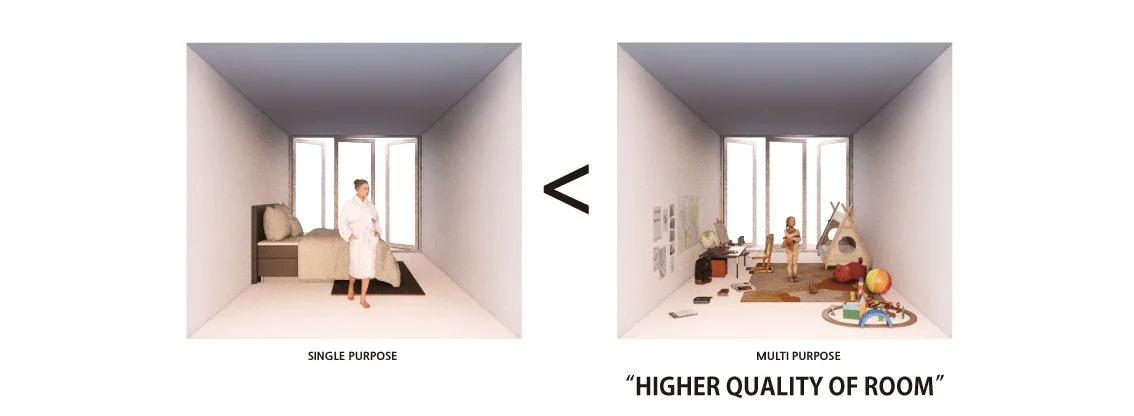현대 가족, 새로운 집의 모습 Modern Families, New Residential Design
최근 1인 주거가 급격히 증가하면서, 다양한 주거 실험과 새로운 시도가 활발히 이루어지고 있다. 이러한 현재 상황 속에서, 30년 전 일본의 한 건축가가 제창했던 흥미로운 개념이 눈에 띄었다. 이 개념은 쿠로사와 타카시(黑沢隆)가 쓴 『개실군주거』(個室群住居)라는 책 속에 담긴 아이디어였으며, 주거의 새로운 대안을 모색할 수 있는 실마리를 제공한다는 생각이 들었다.
As single-person households rapidly increase, a wide range of experimental housing approaches and new attempts are actively emerging. Amidst this current context, a fascinating concept proposed by a Japanese architect some 30 years ago caught my attention. This concept was an idea presented in Kurosawa Takashi’s (黑沢隆) book Individual Room Housing, and it offers a clue for exploring new alternatives in housing.
個室群住居 개실군주거
1966
건축가 쿠로사와 타카시 (黒沢隆)
가나가와 현립 쇼난 고등학교와 일본대학 이공학부 건축 전공 졸업.
일본대학, 시바우라 공업대학 등 다수 대학의 비상근 강사 활동.
후배 건축가 야마모토 리켄과의 역사 연구회 개최. 후학에 대한 큰 영향력.
주요 작품: 주택: 「1/4 원호 IWT」, 「Le Coffre Rouge」, 「아우로라」 「하야미 예술학원」등.
개실군주거(個室群住居)는 개개인의 실이 군집한 주거라는 뜻이다(한문: 個人之室聚集之住宅). 전통적 전용주택은 산업혁명 이후 직장과 집이 분리되면서 필요하게 되었고, 핵가족이 사회의 기본 단위가 되면서 부부와 아이가 사는 nLDK 형태가 등장했다. 이러한 구조는 지금까지 유지되고 있다. 그러나 1960년대 일본 건축가 **쿠로사와 타카시(黑沢隆)**는 가족 중심 구조가 해체되고, 개인이 사회와 직접 연결되는 시대가 올 것이라고 예견했다. 그가 제안한 개인실군 주거는, 부부일체성과 가족 중심 공간 배치를 재검토하며, 각자의 독립된 공간—아이방을 포함한 개인실—을 필요에 따라 선택적으로 연결할 수 있는 형태로 설계되었다.
Individual room housing literally means a housing in which individual rooms are clustered together (Classical Chinese: 個人之室聚集之住宅). Traditional single-family homes emerged after the Industrial Revolution, when work and home life became separated. As nuclear families became the primary social unit, the nLDK type—comprising a couple and children—was established and continues to be common today. However, in the 1960s, Japanese architect Kurosawa Takashi (黑沢隆) predicted that family-centered structures would dissolve and that individuals would increasingly connect directly with society. His concept of individual room housing reconsidered the assumed unity of the couple and family-centered spatial arrangements, designing independent spaces—including children’s rooms—that could be selectively connected according to need.
nLDK
n: 방의 수 (예: 2LDK는 방이 2개)
LDK: Living, DIning, Kitchen
구성원의 방과 함께 모일 수 있는 LDK의 조합된 공간
개실군주거의 가장 큰 혁신은 주거 프로그램의 해체와 재배치에 있다. 기존의 방 이름—침실, 주방, 아이방, 창고, 옷방—은 기능 중심으로 명명되었지만, 방을 사용하는 주체를 충분히 반영하지 못한다. 현대 개실군주거에서는 아빠 A의 방, 엄마 B의 방, 아이 C의 방처럼 각 구성원을 독립된 주체로 보고 재분류한다. 또한, 각 방의 기능은 다기능적으로 확장된다. 아이방이 놀이터, 도서관, 침실, 공부방으로 변할 수 있는 것처럼, 성인에게도 유사한 다기능적 공간이 제공된다. 이러한 주체 중심, 다기능적 설계는 현대 주거에서 건축가가 새롭게 접근해야 할 핵심 과제이다.
The most innovative feature of individual room housing lies in the deconstruction and reorganization of housing programs. Traditional room names—bedroom, kitchen, children’s room, storage, closet—were function-focused and did not fully reflect the users. Contemporary individual room housing treats each occupant as an independent subject, reclassifying spaces such as Father A’s room, Mother B’s room, and Child C’s room. Moreover, each room’s function is extended to be multifunctional. Just as a child’s room can become a playground, library, bedroom, or study, similar multifunctional spaces should be available for adults.
This subject-centered, multifunctional design is a key challenge that architects must address in contemporary housing.
개실군주거는 당시 우리의 주거에 대한 고정관념을 깨는 신선한 개념으로 제시되었으며, 여전히 익숙하지는 않지만 현대 주거에서 변화가 필요하다는 공감대가 형성되고 있는 요즘 한 번쯤 생각해볼 만한 대안 중 하나일 수 있다. 또한, 인터넷의 발달, AI의 등장, 코로나와 같은 팬데믹, 생명 연장 기술 등 새로운 환경적 변화가 발생하면서, 과거 개념을 현대적으로 재해석할 필요가 생겼다. 따라서 개실군주거는 단순한 과거의 유산이 아니라, 계속 고민하고 확장해 나가야 하는 실험적 주거 아이디어로서 의미가 있다.
Individual room housing was presented as a fresh concept that challenged established assumptions about housing at the time. While still unfamiliar, it could be considered one of the alternative ideas worth reflecting on today, as there is growing recognition of the need for change in modern housing. Moreover, the development of the internet, the advent of AI, pandemics like COVID-19, and advances in life-extension technologies have created new environmental conditions, making it necessary to reinterpret past concepts for contemporary application. Thus, individual room housing is not merely a historical relic; it remains a living experimental housing idea to be continuously explored and expanded.



